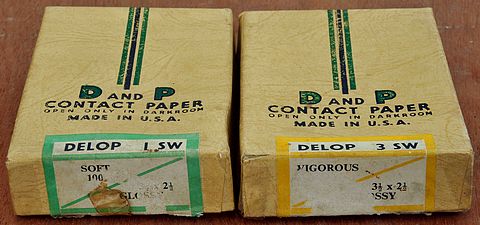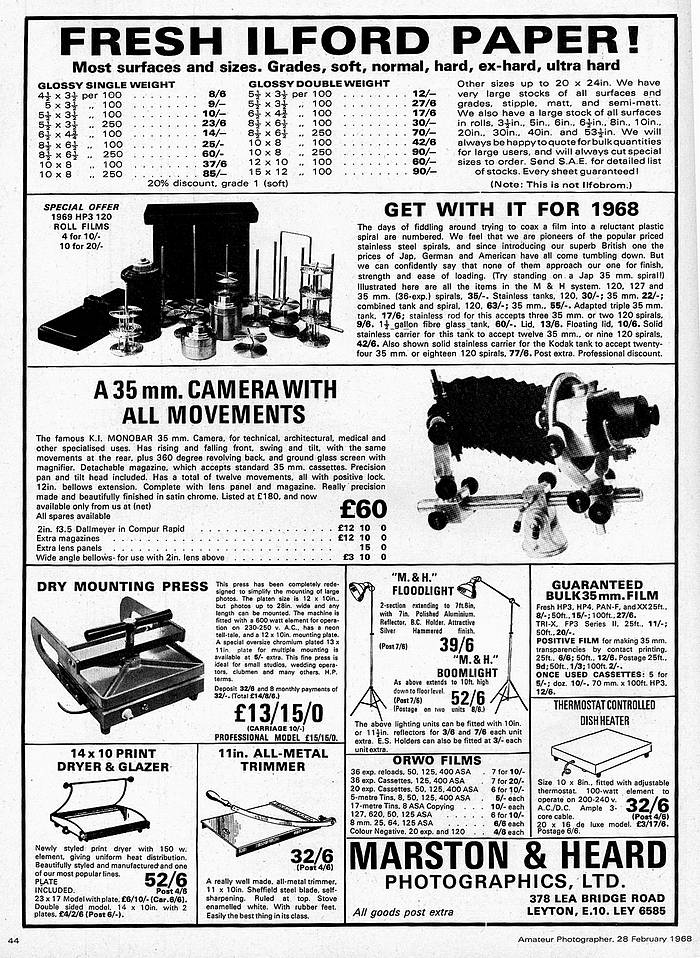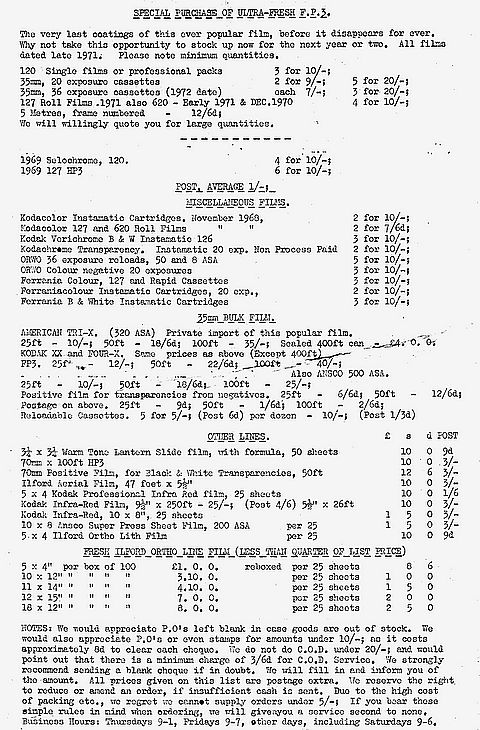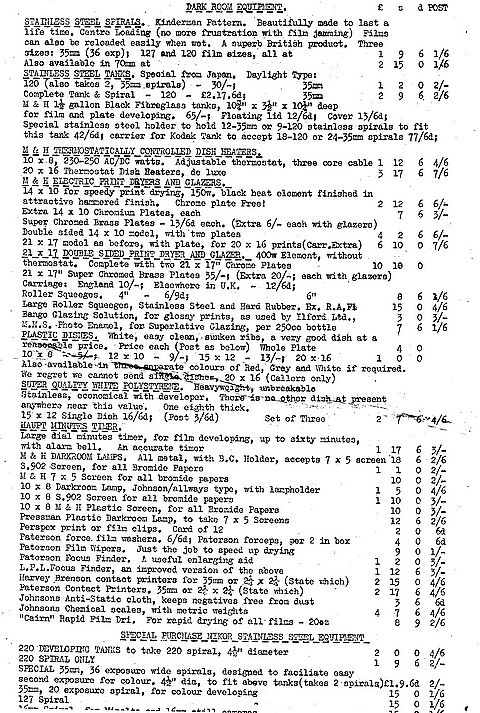|
A.W. Young price lists.
These three price lists originated
from A.W. Young, Photographic and Cine Dealers, 159 Chatsworth
Road, Clapton, London E5. As well as being photographic dealers,
A.W. Young also sold surplus and out-dated photographic goods
and equipment, which included vast quantities of out-dated ex-Government
black and white photographic paper, plus other makes of photographic
paper, such as the American "Haloid", "Barnet",
and repacked Kodak paper.
In 1967 Ilford introduced "Ilfobrom",
a photographic enlarging Bromide paper to replace their well
known Ilford Bromide paper. From 1967 onwards, Ilford sold huge
quantities of Ilford Bromide paper to most photographic dealers
who specialised in selling out-dated black and white photographic
paper. A.W. Young was one of the dealers who took up this option
from Ilford, as can be seen on the price list below, right.
These price lists show the
enormous variations of sizes, quantities and contrast grades
that were offered for sale at discounted prices. The 1969 lists
(below) give prices in £.s.d, the third list dates from
1973 and prices are in decimal currency, £.p
"Soft" contrast grade
paper was usually offered at lower cost than the "Normal"
or "Hard" grades of paper. The reason for this was
that almost all photographers and black and white printers rarely
made use of "soft" grade paper; the vast majority of
negatives would print well on normal and hard grades. Another
reason for the much discounted price of soft grade was Ilford
grade 1 soft (B1.1P) gave a print at least one grade softer than
the equivalent Kodak grade 1 soft paper (WSG 1S).
The Ilford Bromide paper contrast
grade system was at least one grade softer than the equivalent
Kodak contrast grade up and including Ilford Grade 3 (B3.1P).
Ilford Grade 5, Ultra Hard (B5.1P), was offered at almost the
same price as the soft grade for the same reason, i.e. the grade
gave an extremely contrasty result, so that grade 5 Bromide paper
was rarely needed
|
|
To the right is an attempt
to compare contrast grades of Ilfobrom, Ilford Bromide, and Kodak
UK bromide papers. This is based on a chart in the 1968 British
Journal of Photo Annual (BJPA) review of Ilfobrom paper in the
“New Goods” section. The old Ilford Bromide paper had
a gap in contrast grades between Grade 3 Hard and Grade 4
Extra Hard.
Table of the comparison of
contrast grades of Ilfobrom paper and Ilford Bromide paper from
the review in the “New Goods” section on Ilfobrom paper
in the British Journal of Photography Annual of 1968. The Kodak
Bromide U.K. made paper grades have been added for interest.
All grade comparisons are approximate and depend on type of enlarger
used and print developer.
The contrast grades 0, 4, and
5 were in most cases made only in a glossy surface. In the late
1960s Kodak UK manufactured a gloss surface paper in “Special
Contrast”, which was mid way between Kodak Grade 1 and Kodak
Grade 2. All bromide papers deteriorate over time, and buying
from a “surplus stock” photographic dealer meant that
paper advertised as Grade 2 Normal might have produced prints
which resembled a Grade 1 Soft paper depending on how old
the paper was.
|
| |
Contrast Grades |
| Ilford Ilfobrom
contrast grades |
0 |
1 |
2 |
3 |
4 |
5 |
| Ilford Bromide
contrast grades |
1 |
2 |
3 |
|
4 |
5 |
| Kodak Bromide
(UK made) contrast grades |
0 |
1 |
2 |
3 |
4 |
|
For example:
A Kodak Bromide paper (UK made) of Grade 2 produced approximately
the same contrast as an Ilford Bromide paper of contrast Grade
3. |
|
|
To the right are shown two
boxes of 'surplus stock' re-packed, American made, 'contact'
paper in contrast grades 'Soft' and 'Vigorous'. Both boxes originally
held 100 sheets of Glossy, Single Weight, paper of size 3½ x 2½ inches
(suited to contact printing negatives from '8 on 120' or '8 on
620' film).
In 1969 the author (Michael
Talbert) purchased a box of re-packed Kodak Bromide paper in
Grade 3, Hard, from A.W.Young by mail order. That paper was also
labelled 'DELOP' and the sealing labels were similar to the labels
on these two boxes.
The age of these boxes is uncertain,
but the printing of the black and green vertical lines has a
resemblance to the red and black vertical lines printed onto
the Kodak photographic paper boxes and packets of the 1940s and
1950s. The Grade 3 box is termed 'Vigorous' rather than
'Hard', giving the impression that the paper dates from the 1950s.
As the sealing labels (shown here) are alike to the labels used
on A.W.Young Bromide paper, there is a possibility that the boxes
(shown here) were sold by A.W.Young.
|
 |



.jpg)
.jpg)
.jpg)
.jpg)
.jpg)
.jpg)
.jpg)
.jpg)
.jpg)
.jpg)
